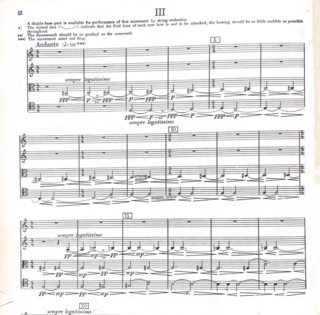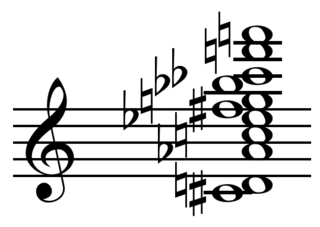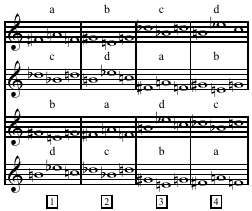Related Research Articles

Milton Byron Babbitt was an American composer, music theorist, mathematician, and teacher. He was a Pulitzer Prize and MacArthur Fellowship recipient, recognized for his serial and electronic music.
Alfred Whitford (Fred) Lerdahl is the Fritz Reiner Professor Emeritus of Musical Composition at Columbia University, and a composer and music theorist best known for his work on musical grammar and cognition, rhythmic theory, pitch space, and cognitive constraints on compositional systems. He has written many orchestral and chamber works, three of which were finalists for the Pulitzer Prize for Music: Time after Time in 2001, String Quartet No. 3 in 2010, and Arches in 2011.
Mario Davidovsky was an Argentine-American composer. Born in Argentina, he emigrated in 1960 to the United States, where he lived for the remainder of his life. He is best known for his series of compositions called Synchronisms, which in live performance incorporate both acoustic instruments and electroacoustic sounds played from a tape.

Marion Eugénie Bauer was an American composer, teacher, writer, and music critic. She played an active role in shaping American musical identity in the early half of the twentieth century.

Ruth Crawford Seeger's String Quartet (1931) is "regarded as one of the finest modernist works of the genre". It was funded by the Guggenheim Foundation and written in the spring of 1931, during Crawford's time in Berlin. It was first published in the New Music Edition in January 1941.

In musical composition, a sound mass(also sound collective, sound complex, tone shower, sound crowd, or cloud) is the result of compositional techniques, in which, "the importance of individual pitches", is minimized, "in preference for texture, timbre, and dynamics as primary shapers of gesture and impact", obscuring, "the boundary between sound and noise".

Anahid Marguerite Ajemian was an American violinist of Armenian descent. Her career in contemporary music began from her desire to help young composers of her generation get their compositions performed. Additionally, she enjoyed performing the music of established contemporary composers. She included these composers with the traditional repertoire in her performances.

Donald James Martino was a Pulitzer Prize winning American composer.
Richard G. Swift was an American composer and music theorist.

Composition for Four Instruments (1948) is an early serial music composition written by American composer Milton Babbitt. It is Babbitt's first published ensemble work, following shortly after his Three Compositions for Piano (1947). In both these pieces, Babbitt expands upon the methods of twelve-tone composition developed by Arnold Schoenberg. He is notably innovative for his application of serial techniques to rhythm. Composition for Four Instruments is considered one of the early examples of “totally serialized” music. It is remarkable for a strong sense of integration and concentration on its particular premises—qualities that caused Elliott Carter, upon first hearing it in 1951, to persuade New Music Edition to publish it.
The Composers String Quartet was a string quartet best known for performances of new works by contemporary composers, including quartets by Elliott Carter and Ruth Crawford Seeger. Carter's Fourth Quartet was dedicated to the Composers Quartet, who premiered the work in 1986. The group has performed quartets by more than 60 American composers, and has toured abroad extensively.
Composition for Twelve Instruments is a serial music composition written by American composer Milton Babbitt for flute, oboe, clarinet, bassoon, horn, trumpet, harp, celesta, violin, viola, cello, and double bass. In it Babbitt for the first time employs a twelve-element duration set to serialize the rhythms as well as the pitches, predating Olivier Messiaen's (non-serial) "Mode de valeurs et d'intensités", but not the Turangalîla-Symphonie (1946–1948), in which Messiaen used a duration series for the first time in the opening episode of the seventh movement, titled "Turangalîla II".
String Quartet No. 3 is the third of six chamber-music works in the string quartet medium by the American composer Milton Babbitt.
String Quartet No. 4 is the fourth of six chamber music works in the string quartet medium by the American composer Milton Babbitt.
String Quartet No. 5 is the fifth of six chamber music works in the string quartet medium by the American composer Milton Babbitt.
String Quartet No. 6 is the last of six chamber-music works in the string quartet medium by the American composer Milton Babbitt.
All Set, for jazz ensemble, is a 1957 composition for small jazz band by the American composer Milton Babbitt.
Matthew Jonathan Greenbaum is an American musician, composer and author.
Bernard Zaslav was an American viola soloist and chamber musician with an extensive recording and performance career. A founding member of The Composers Quartet in 1965, he went on to play with the Fine Arts Quartet, Vermeer Quartet, and the Stanford String Quartet. He has also performed and recorded as the Zaslav Duo with his wife, pianist Naomi Zaslav.
References
- ↑ Griffiths 1974.
- ↑ Straus 1986, 22.
Sources
- Griffiths, Paul. 1974. "String Quartet by Crawford Seeger; The Composers Quartet; String Quartet No. 5 by Perle; The Composers Quartet; String Quartet No. 2 by Babbitt; The Composers Quartet". The Musical Times 115, no. 1573 (March): 222.
- Straus, Joseph N. 1986. "Listening to Babbitt". Perspectives of New Music 24, no. 2 (Spring–Summer): 10–24.